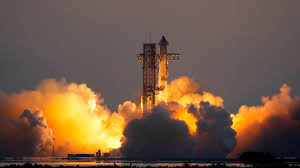
The Starship rocket booster, also known as the Super Heavy booster, is part of SpaceX’s ambitious Starship project. This project aims to create a fully reusable spacecraft capable of carrying both crew and cargo to destinations in deep space, including Mars and beyond. The rocket booster is the first stage of the two-stage Starship system, which provides the necessary thrust to launch the Starship into orbit.
Key Features:
Height: 70 meters (230 feet)
Diameter: 9 meters (30 feet)
Thrust: 16 million pounds of force (approximately twice the thrust of NASA’s Saturn V rocket)
Innovative Design and Engineering
The Starship booster is powered by an array of Raptor engines, which are a key innovation in themselves. These engines use a full-flow staged combustion cycle, burning methane and liquid oxygen as propellants. The use of methane as fuel is particularly innovative because it can be synthesized on Mars, enabling refueling for return trips.
Design Highlights:
Raptor Engines: The Super Heavy booster is equipped with up to 33 Raptor engines, providing unparalleled power for heavy payload launches.
Reusability: The booster is designed to be fully reusable, meaning it can land back on Earth after launching the Starship and be prepared for another flight. This dramatically reduces the cost of space launches.
Stainless Steel Structure: The booster is constructed from stainless steel, which offers durability and strength while being cost-effective.
Flight and Launch Capabilities
The primary function of the Starship rocket booster is to provide the initial thrust needed to launch the Starship spacecraft into orbit. Once the spacecraft is launched, the booster detaches and returns to Earth for recovery and reuse. The sheer power of the booster allows it to carry heavy payloads into space, making it ideal for a wide range of missions, from satellite deployment to interplanetary exploration.
Performance Metrics:
Payload Capacity: The Starship system, with the booster, is designed to carry more than 100 metric tons of cargo into low Earth orbit (LEO).
Speed and Altitude: The booster can launch payloads into space at speeds exceeding Mach 25, reaching altitudes well beyond LEO.
Reusability and Cost Efficiency
One of the most revolutionary aspects of the Starship rocket booster is its reusability. SpaceX aims to recover and reuse the booster multiple times, similar to how commercial airplanes are reused. This could drastically reduce the cost of each space mission, opening up new possibilities for space exploration, research, and even commercial space travel.
Benefits of Reusability:
Lower Launch Costs: By reusing the booster, SpaceX can reduce the cost of launching payloads into space, making space more accessible for commercial and governmental missions.
Sustainability: The reusability of the booster also reduces waste and the environmental impact of space travel.
Rapid Turnaround: SpaceX envisions rapid turnaround times for the booster, enabling frequent space launches.
Role in SpaceX’s Mars Mission
The Starship rocket booster plays a pivotal role in SpaceX’s long-term mission to colonize Mars. The booster’s massive thrust capacity is essential for launching the Starship spacecraft, which is designed to carry large numbers of passengers and cargo on interplanetary journeys. With its ability to be refueled on Mars, the Starship system could enable a two-way trip between Earth and Mars, making human colonization of the red planet feasible.
Future Prospects:
Interplanetary Travel: The booster’s power and reusability are critical to SpaceX’s vision of establishing a permanent human presence on Mars.
Cargo and Human Transport: The Starship rocket booster could support missions that transport massive amounts of cargo or large numbers of humans, advancing deep-space exploration.
Challenges and Future Development
While the Starship rocket booster represents a major step forward, there are still technical and regulatory challenges to overcome. Successfully landing and reusing such a massive rocket is a complex task that SpaceX continues to refine through test flights. Additionally, regulatory approvals and safety concerns will need to be addressed before the booster can be used for regular commercial flights.
Key Challenges:
Landing Precision: Achieving consistent landing precision to reuse the booster efficiently.
Environmental Impact: Managing the environmental impact of methane production and rocket emissions.
Regulatory Hurdles: Gaining approval from international space agencies for launches and landings in various countries.
The Starship rocket booster is set to be a game-changer in the space industry. Its unprecedented power, reusability, and cost efficiency have the potential to make space travel more accessible and sustainable than ever before. As SpaceX continues to push the boundaries of space exploration, the Starship rocket booster will be a critical component in humanity’s journey to the stars, paving the way for missions to the Moon, Mars, and beyond.
Subscribe to Follow Global Trends for daily global news.
Find Out How To Make Money As A Full Time Writer/Blogger Guide.
To Advertise, Advertise Your Affiliate Links on FollowGlobalTrends.com for Just $1 Per Link Per Month!
Related Articles
Written By: Enyoghasi Ngozi pricillia
,

